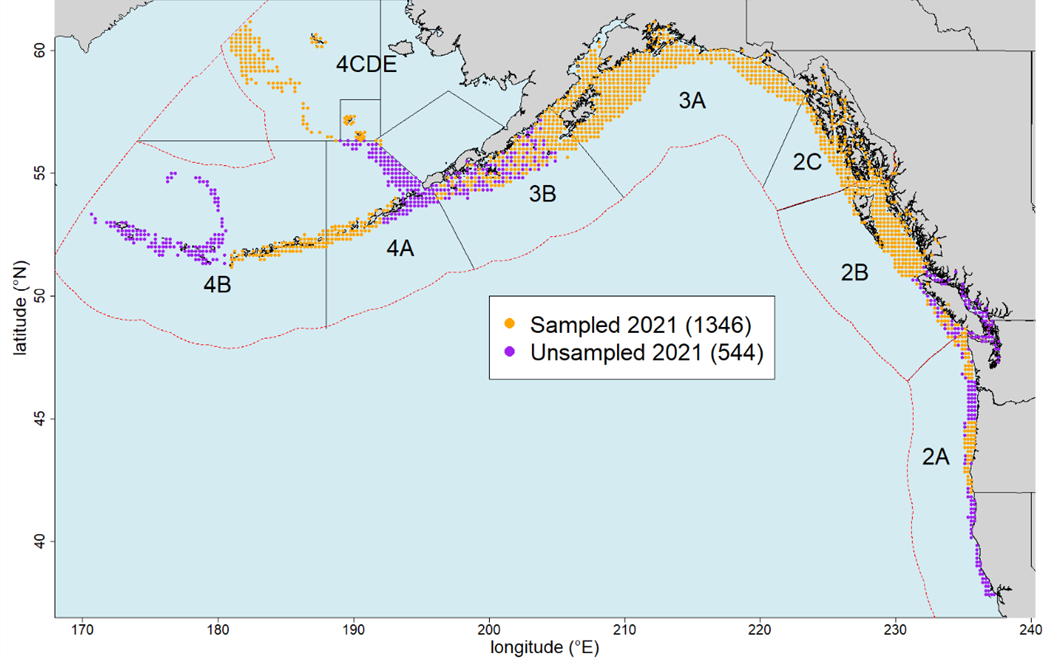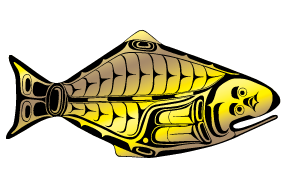11 February 2021
SEATTLE – The International Pacific Halibut Commission (IPHC) completed the 97th Session of the IPHC Annual Meeting (AM097) on 29 January 2021 with decisions on total mortality limits, fishery limits, fishing period dates, and other fishery regulation changes. A total of 270 individuals attended the meeting via the electronic platform.
Meeting documents, presentations, recordings of the sessions, and the report of the meeting are available on the AM097 meeting page at the IPHC website: 97th Session of the IPHC Annual Meeting (AM097) | IPHC.
IPHC Media Release 2021-005 reported the initial results of AM097. Selected additional elements of the Report of the 97th Session of the IPHC Annual Meeting are highlighted below.
PACIFIC HALIBUT STOCK STATUS AND OUTLOOK
The Commission NOTED the following scientific advice from the IPHC Secretariat:
“Sources of mortality: In 2020, total Pacific halibut mortality due to fishing was down to 35.50 million pounds (16,103 t) from 39.87 million pounds (18,086 t) in 2019. Of that total, 84% comprised the retained catch, up from 81% in 2019.”
“Stock status (spawning biomass): Current (beginning of 2021) female spawning biomass is estimated to be 192 million pounds (87,050 t), which corresponds to a 41% chance of being below the IPHC trigger reference point of SB30%, and less than a 1% chance of being below the IPHC limit reference point of SB20%. Relative female spawning biomass at the beginning of 2021 was estimated to be at 33% of the unfished state, with a 41% chance of being below the IPHC trigger reference point of SB30%, and less than a 1% chance of being below the IPHC limit reference point of SB20%. Therefore, the stock is considered to be ‘not overfished’ (SB2021 > SB20%). Projections indicate that mortality consistent with the interim management procedure reference fishing intensity (F43%) is likely to result in further declining biomass levels in the near future.”
“Fishing intensity: The 2020 mortality corresponded to a point estimate of SPR = 48%; there is a 38% chance that fishing intensity exceeded the IPHC’s current reference level of 43%. The Commission does not currently have a coastwide fishing intensity limit reference point. However, given that the stock is above the spawning biomass limit reference point, the stock is by default classified as ‘not subject to overfishing’.”
“Stock distribution: The proportion of the coastwide stock represented by Biological Region 3 has been decreasing since 2004, and increasing in Biological Regions 2 and 4. However, there was an increase in Biological Region 3 in 2020 and a decrease in Biological Region 2. Biological Region 4 is near the historical high estimated for 2019, and has shown an increasing trend since the early 1990s.”
The Commission NOTED the following outlook for the stock provided by the IPHC Secretariat:
“Outlook. The stock is projected to decrease with at least a 51% chance over the period from 2021-23 for all TCEYs greater than the “3-year surplus” of 24.4 million pounds (~11,068 t), corresponding to a projected SPR of 58% (credible interval 39-76%). At the status quo TCEY (36.6 million lb, (~16,600 t)), the probability of spawning biomass decline is 62% and 61% for one and three years, respectively. At the reference level (a projected SPR of 43%) the probability of spawning biomass declining to 2022 is 65%, decreasing to 63% in three years, as the 2011 and 2012 cohorts mature. The one-year risk of the stock dropping below SB30% ranges from 35% (at the 3-year surplus level) to 41% at the reference TCEY. Over three years these probabilities range from 29% to 44% depending on the level of mortality.”
IPHC PACIFIC HALIBUT FISHERY REGULATIONS 2021
The Commission approved a series of IPHC fishery regulation changes for 2021, including fishery limits and fishing periods. In accordance with the IPHC Convention[1], the fishery regulations approved by the IPHC have been recommended to the Contracting Parties for implementation according to their domestic laws. The complete IPHC Fishery Regulations (2021) approved by the Commission will be published on the IPHC website in the coming days (https://www.iphc.int/the-commission).
Morality and Fishery Limits (Sect. 5)
The Commission ADOPTED the distributed mortality limits for each Contracting Party, by IPHC Regulatory Area and sector, as provided below:
Adopted TCEY mortality limits for 2021
| Contracting Party IPHC Regulatory Area | Mortality limit (TCEY) (metric tonnes) | Mortality limit (TCEY) (mlbs) |
| Canada Total: 2B | 3,175 | 7.00 |
| USA: 2A | 748 | 1.65 |
| USA: 2C | 2,631 | 5.80 |
| USA: 3A | 6,350 | 14.00 |
| USA: 3B | 1,415 | 3.12 |
| USA: 4A | 930 | 2.05 |
| USA: 4B | 635 | 1.40 |
| USA: 4CDE | 1,805 | 3.98 |
| United States of America Total | 14,515 | 32.00 |
| Total (IPHC Convention Area) | 17,690 | 39.00 |
Commercial fishing periods (Sect. 9)
The Commission ADOPTED fishing periods for 2021 as provided below, thereby superseding the relevant portions of Section 9 of the IPHC Pacific halibut fishery regulations by specifying that commercial fishing for Pacific halibut in all IPHC Regulatory Areas may begin no earlier than 6 March and must cease on 7 December.
The Commission ADOPTED changes to the derby season structure for the IPHC Regulatory Area 2A fishery from openings Monday through Wednesday, to openings Tuesday through Thursday.
Charter management measures in IPHC Regulatory Areas 2C and 3A (Sect. 29)
The Commission ADOPTED changes for charter recreational Pacific halibut fisheries in IPHC Regulatory Areas 2C and 3A, in order to achieve the charter Pacific halibut allocation under the North Pacific Fisheries Management Council’s (NPFMC) Pacific halibut Catch Sharing Plan:
- IPHC Regulatory Area 2C – one-fish bag limit with size limit of less than or equal to 50 inches or greater than or equal to 72 inches;
- IPHC Regulatory Area 3A – two-fish bag limit with one fish of any size and a second fish less than or equal to 32 inches, Wednesdays closed to retention of Pacific halibut, one trip per vessel and one trip per permit per day (no annual limit).
OTHER ACTIONS
Commercial Fishing Period
The Commission RECOMMENDED that further consultations between Contracting Parties and fishery stakeholders on the administrative and policy implications of a year round fishery would support the decision process for the 98th Session of the IPHC Annual Meeting (AM098; January 2022) on potential further extensions of the direct commercial fishing period.
IPHC Fishery-Independent Setline Survey (FISS)
The Commission NOTED the updated information presented by the IPHC Secretariat on IPHC Regulatory Areas 4B and 2A FISS design, costs and estimated revenues. No further amendments to the 2021 FISS design approved at the 9th Special Session of the Commission (SS09) were made.

Figure. Optimised ‘minimum 2021 FISS design’ (orange circles) based on randomised sampling in 2B-3B, and a subarea design elsewhere. Purple circles are not planned for sampling in 2021.
Upcoming IPHC meetings
| Meeting | Date | Location |
| 97th Session of the IPHC Interim Meeting (IM097) | 30 November – 1 December 2021 | Seattle, WA, USA |
| 98th Session of the IPHC Annual Meeting (AM098) | 24-28 January 2022 | Seattle/Bellevue, WA, USA |
Officers of the Commission
The Commission elected Mr Glenn Merrill (USA) as Chairperson of the IPHC, and Mr Paul Ryall (Canada) as Vice-Chairperson of the IPHC.
For further information please contact the IPHC Secretariat at secretariat@iphc.int or 206.634.1838.
[1] The Convention between Canada and the United States of America for the Preservation of the [Pacific] Halibut Fishery of the Northern Pacific Ocean and Bering Sea.
IPHC Secretariat
International Pacific Halibut Commission
2320 W. Commodore Way, Suite 300
Seattle, WA 98199-1287
206-634-1838 | www.iphc.int

